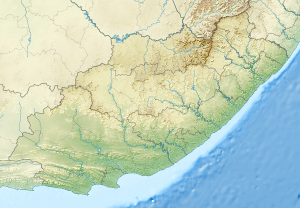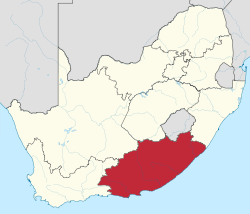East London Airport
| East London Airport | |||||||||||||||
|---|---|---|---|---|---|---|---|---|---|---|---|---|---|---|---|
 | |||||||||||||||
| IATA: ELS – ICAO: FAEL | |||||||||||||||
| Summary | |||||||||||||||
| Airport type | Public | ||||||||||||||
| Serves | East London, Eastern Cape, South Africa | ||||||||||||||
| Elevation AMSL | 436 ft / 133 m | ||||||||||||||
| Coordinates | 33°02′06″S 027°49′17″E / 33.03500°S 27.82139°ECoordinates: 33°02′06″S 027°49′17″E / 33.03500°S 27.82139°E | ||||||||||||||
| Website | http://www.airports.co.za/airports/east-london | ||||||||||||||
| Map | |||||||||||||||
 FAEL Location of airport in Eastern Cape province Location of Eastern Cape in South Africa  | |||||||||||||||
| Runways | |||||||||||||||
| |||||||||||||||
East London Airport (IATA: ELS, ICAO: FAEL) is an airport serving East London, a city in the Eastern Cape province on the southeast coast of South Africa.
East London's airport is a small but bustling one that plays an important role in the growing economy of the Eastern Cape. Every day it welcomes between 20 and 30 flights – which bring 346,000 people to East London each year. Of these, about 140,000 are holidaymakers, mostly local, and about 15% are foreign tourists. In 2013, the airport served 658,363 passengers.
History
The airport had an inauspicious beginning in 1927, when Lieut Colonel Alistair Miller asked the East London town council to help establish a municipal aerodrome at Woodbrook, west of the city.
Passenger flights were undertaken by two de Havilland Moth planes on Saturday afternoons and all day on Sundays, weather permitting. Flights could also be booked for weekdays, but only by special arrangement. In 1931 it took 11 hours to fly from Windhoek in Namibia to East London.
In 1944 a new airport was built at Collondale, about 2 km west of the present terminal building.
In 1965 the airport was again moved, this time to its present site, 9 km west of the city centre. Construction of the terminal buildings finished in 1966, and the airport was named after Ben Schoeman, the minister of transport at the time.
The airport was renamed in 1994. Since then, major alterations to the terminal building have been completed and a new first-floor office development for the airport management team has been added.
Facilities
East London Airport resides at an elevation of 435 feet (133 m) above mean sea level. It has two asphalt paved runways: 11/29 is 1,939 by 46 metres (6,362 ft × 151 ft) and 06/24 is 1,585 by 46 metres (5,200 ft × 151 ft).[1]
Airlines and destinations
Traffic statistics
| Year | Passengers | % Change |
|---|---|---|
| 2006 | 664,824 | |
| 2007 | 744,949 | |
| 2008 | 715,206 | |
| 2009 | 675,980 | |
| 2010 | 671,895 | |
| 2011 | 681,741 | |
| 2012 | 663,115 | |
| 2013 | 658,363 | |
Incidents
- On 13 March 1967, South African Airways Flight 406 crashed into the Indian Ocean while on approach to East London Airport. All 25 passengers and crew on board were killed.
See also
References
- 1 2 "FAEL – EAST LONDON" (PDF). South African Civil Aviation Authority. Effective 4 April 2013. Check date values in:
|date=(help) - ↑ Airport information for FAEL from DAFIF (effective October 2006)
- ↑ Airport information for ELS at Great Circle Mapper. Source: DAFIF (effective October 2006).
- ↑ "ACSA Passenger Statistics". Airports Company South Africa. Retrieved 23 October 2013.
External links
- East London Airport, official site
- Aeronautical chart for FAEL at SkyVector
- Current weather for FAEL at NOAA/NWS
- Accident history for ELS at Aviation Safety Network